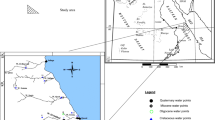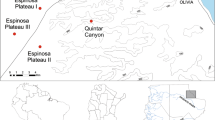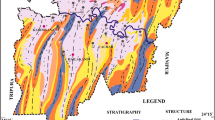Abstract
Geomorphological (landform) aspects have long been known to control groundwater conditions in an area. Thus, combining the hydrogeological and geomorphological aspects (lithology, genesis, and morphology) becomes a prospective approach for understanding and delineating the hydrogeochemical processes in an area. The idea is then applied in Kulonprogo, Java, Indonesia, that consists of several landforms with minimum anthropogenic influence, in order to identify and quantify the hydrogeochemical processes that are responsible for hydrogeochemical facies changes in each landform. The groundwater facies based on Kurlov classification in each landform are strongly influenced by the water–rock interaction process as it presented in the Gibbs curve. The magnitude of saturation indices and mass transfer is also diverse that caused a distinction of hydrogeochemical facies and processes in each landform. For instance, the evolution of groundwater in the denudational hill to the fluviomarine plain occurs from Ca–HCO3 to Na + K–Ca–HCO3. The analysis of Durov diagram and inverse modeling—using PHREEQ—reveals that the hydrogeochemical processes that occur in most of the landform are ion exchange, weathering or dissolution, and precipitation. Further, oxidation–reduction and mixing only occur in few landforms. The further investigation from mass balance calculation that constructs from inverse modeling reveals some interesting findings and hypotheses, such as the construction of gypsum probably found in the deeper layer on swale as a result of pyrite dissolution of 1.074 × 10−3 mmol, and it is responsible in escalating Ca2+ and SO42−. Another finding is that although the calcite mineral mostly related to the past-marine environment, such as in the east denudational hill, the calcite in the west part is formed as a breakdown of 3.225 × 10−3 mmol anorthite.









Similar content being viewed by others
References
Abdel Wahed MSM, Mohamed EA, El-Sayed MI, M’nif A, Sillanpää M (2015) Hydrogeochemical processes controlling the water chemistry of a closed saline lake located in Sahara Desert: Lake Qarun, Egypt. Aquat Geochem 21(1):31–57. https://doi.org/10.1007/s10498-015-9253-3
Adji TN, Sejati SP (2014) Identification of groundwater potential zones within an area with various geomorphological units by using several field parameters and a GIS approach in Kulonprogo Regency, Java, Indonesia. Arabian J Geosci 7:161. https://doi.org/10.1007/s12517-012-0779-z
Adji TN, Widyastuti M (2005) Application of inverse modeling technique to describe hydrogeochemical processes responsible to spatial distribution of groundwater quality along flowpath. Indones J Geogr 37(2):85–102
Alpers CN, Nordstrom DK (1999) Geochemical modeling of water–rock interactions in mining environments, chapter 14. In: Plumlee GS, Logsdon MJ (eds) The environmental geochemistry of mineral deposits. Part A. Processes, methods, and health issues. Society of Economic Geologists, Littleton, Colorado, Reviews in Economic Geology, vol 6A, pp 289–323
Appelo CAJ, Postma D (2005) Geochemistry, groundwater, and pollution, 2nd edn. A.A. Balkema Publishers, Amsterdam
Belkhiri L, Mouni L, Tiri A (2011) Water–rock interaction and geochemistry of groundwater from the Ain Azel aquifer, Algeria. Environ Geochem Health 34(1):1–13. https://doi.org/10.1007/s10653-011-9376-4
Blanchette D, Lefebvre R, Nastev M, Cloutier V (2010) Groundwater quality, geochemical processes and groundwater evolution in the Chateauguay River Watershed, Quebec, Canada. Can Water Resour J 35(4):503–526. https://doi.org/10.4296/cwrj3504503
Chilingar GV (1956) Durov’s classification of natural waters and chemical composition of atmospheric precipitation in the USSR: a review. Am Geophys Union 37:193–196
Cloutier V, Lefebvre R, Savard MM, Bourque E, Therrien R (2006) Hydrogeochemistry and groundwater origin of the Basses-Laurentides sedimentary rock aquifer system, St. Lawrence Lowlands, Quebec, Canada. Hydrogeol J 14:573–590
Dana ES (1949) Mineralogy. Wiley, New York
Darcy H (1856) Les Fontaines Publiques de la Ville de Dijon. Dalmont, Paris
de Marsily G (1986) Quantitative hydrogeology. Academic Press, Orlando
Domenico PA, Schwartz FW (1998) Physical and chemical hydrogeology. Wiley, New York
Dragon K, Gorski J (2012) Identification of groundwater chemistry origins in a regional aquifer system (Wielkopolska region, Poland). Environ Earth Sci 72(5):2153–2167. https://doi.org/10.1007/s12665-014-3567-0
Edmunds WM, Shand P (2008) Groundwater baseline quality. In: Edmunds WM, Shand P (eds) Natural groundwater quality. Blackwell Publishing, Malden, pp 1–21
El-Kadi AI, Plummer L, Aggarwal P (2011) NETPATH-WIN: an interactive user version of the mass-balance model, NETPATH. Groundwater 49:593–599. https://doi.org/10.1111/j.1745-6584.2010.00779.x
Frape SK, Fritz P, McNutt RH (1984) Water–rock interaction and chemistry of groundwaters from the Canadian Shield. Geochim Cosmochim Acta 48(8):1617–1627
Furi W, Razack M, Abiye TA, Kebede S, Legesse D (2012) Hydrochemical characterization of complex volcanic aquifers in a continental rifted zone: the middle Awash basin, Ethiopia. Hydrogeol J 20(2):385–400. https://doi.org/10.1007/s10040-011-0807-1
Gray WG, Miller CT (2004) Examination of Darcy’s law for flow in porous media with variable porosity. Environ Sci Technol 38:22. https://doi.org/10.1021/es049728w
Hadmoko DS, Lavigne F, Sartohadi J, Hadi MP, Winaryo (2010) Landslide hazard and risk assessment and their application in risk management and landuse planning in eastern flank of Menoreh mountains, Yogyakarta Province, Indonesia. Nat Hazards 54:623–642. https://doi.org/10.1007/s11069-009-9490-0
Harsono P (1968) On the age of the Sentolo Formation based on planktonic foraminifera. Bandung Institute Technology, Department of Geology Control, No. 64, pp 5–21
Helena B, Pardo R, Vega M, Barrado E, Fernandez JM, Fernandez L (2000) Temporal evolution of groundwater composition in an alluvial aquifer (Pisuerga River, Spain) by Principal Component Analysis. Water Res 34(3):807–816
Hiscock KM, Bense VF (2014) Hydrogeology: principles and practices, 2nd edn. Wiley Blackwell, London
Huggett RJ (2011) Fundamentals of geomorphology, 3rd edn. Routledge, New York
Kadar D (1975) Planktonic foraminifera from the lower part of the Sentolo Formation, Central Java, Indonesia. J Foraminifer Res 5(1):1–20
Khatri N, Tyagi S (2015) Influences of natural and anthropogenic factors on surface and groundwater quality in rural and urban areas. Front Life Sci 8(1):23–39. https://doi.org/10.1080/21553769.2014.933716
King CAM (1972) Beaches and coasts. Edward Arnold, London
Kresic N (2006) Hydrogeology and groundwater modeling, vol 2, 2nd edn. CRC Press, Boca Raton
Li Y (1995) Geochemical mass balances of major chemical constituents in the watershed of the Changhuajian River in China. Aquat Geochem 1(2):147–156. https://doi.org/10.1007/bf00702888
Lloyd JW, Heathcote JA (1985) Natural inorganic hydrochemistry in relation to groundwater. Clarendon Press, Oxford
Logan WS, Nicholson RV (1997) Origin of dissolved groundwater sulphate in coastal plain sediments of the Rio de la Plata, Eastern Argentina. Aquat Geochem 3(4):305–328. https://doi.org/10.1023/a:1009680326095
Luo W, Gao X, Zhang X (2018) Geochemical processes controlling the groundwater chemistry and fluoride contamination in the Yuncheng Basin, China—an area with complex hydrogeochemical conditions. PLoS ONE 13(7):e0199082. https://doi.org/10.1371/journal.pone.0199082
MacDonald and Partner, Binnie and Partner Hunting Technical Service Ltd. (1984) Greater Yogyakarta groundwater resources study, Vol. 3 Groundwater, Indonesia. Groundwater Development Project (P2AT), Ministry of Public Works, Government of Republic Indonesia
Machusak DD, Kump LR (1997) Environmental controls on groundwater chemistry in an offshore island aquifer: Fiesta Key, Florida. Aquat Geochem 3(2):129–167. https://doi.org/10.1023/a:1009648200301
Mazor E, Drever JI, Finley J, Huntoon PW, Lundy DA (1993) Hydrochemical implications of groundwater mixing: an example from the Southern Laramie Basin, Wyoming. Water Resour Res 29(1):193–205. https://doi.org/10.1029/92wr01680
Nielsen DM, Nielsen GL (2006) The essential handbook of groundwater sampling. CRC Press, Boca Raton
Nordstrom DK, Ball JW, Donahoe RJ, Whittemore D (1989) Groundwater chemistry and water–rock interactions at Stripa. Geochim Cosmochim Acta 53(8):1727–1740
Nourtier-Mazauric E, Guy B, Fritz B, Borsse E, Garcia D, Clément A (2005) Modelling the dissolution/precipitation of ideal solid solutions. Oil Gas Sci Technol 60(2):401–415
Pacheco F, van der Weijden CH (1996) Contributions of water–rock interactions to the composition of groundwater in areas with a sizeable anthropogenic input: a case study of the waters of the Fundão Area, Central Portugal. Water Resour Res 32(12):3553–3570
Parkhurst DL, Appelo CAJ (1999) User’s guide to PHREEQC (Version 2)—a computer program for speciation, batch-reaction, one-dimensional transport, and inverse geochemical calculations. U.S. Geological Survey, Water-Resources Investigations Report 99-4259, Washington
Plummer LN, Parkhurst DL, Thorstenson DC (1983) The development of reaction models for ground-water systems. Geochim Cosmochim Acta 47:665–686
Plummer LN, Prestemon EC, Parkhurst DL (1991) An interactive code (NETPATH) for modeling net geochemical reactions along a flow path. U.S. Geological Survey. Water-Resources Investigations Report 91-4078
Rhoades JD, Kandiah A, Mashali A (1992) The use of saline waters for crop production. FAO, Rome
Richardson JL, Wilding LP, Daniels RB (1992) Recharge and discharge of groundwater in aquatic conditions illustrated with flownet analysis. Geoderma 53:65–78
Santosa LW (2012) Hidrostratigrafi Akuifer sebagai Geoindikator Genesis Bentuklahan di Wilayah Kepesisiran Kabupaten Kulonprogo (Hydrostratigraphic aquifer as a geoindicator of landforms genesis in the coastal region of Kulonprogo Regency, Special Region of Yogyakarta). Daerah Istimewa Yogyakarta. Forum Geogr 26(2):160–177 (in Bahasa Indonesia with English abstract)
Schot PP, van der Wal J (1992) Human impact on regional groundwater composition through intervention in natural flow patterns and changes in land use. J Hydrol 134:297–313
Summerfield MA (2013) Global geomorphology, 2nd edn. Routledge, New York
Sunarto (2014) Geomorphology and contribution in the conservation of aeolian sand dune coast from agrogenic and urbanogenic disasters. Inauguration Speech of Professor Position at the Faculty of Geography, Gadjah Mada University, Yogyakarta
Syafri I, Budiadi E, Sudradjat A (2013) Geotecnic configuration of Kulon Progo Area, Yogyakarta. Indones J Geol 8(4):185–190
Todd DK, Mays LW (2005) Groundwater hydrology, 3rd edn. Wiley, New York
van Bemmelen RW (1949) The geology of Indonesia: general geology of Indonesia and adjacent archipelagoes. Government Printing Office, The Hague
van Zuidam RA (1983) Guide to geomorphology aerial photographic interpretation and mapping. ITC Enschede, Enschede
van Zuidam RA (1985) Aerial photo—interpretation in terrain analysis and geomorphological mapping. Smith Publisher, The Hague
Verstappen TH (1983) Applied geomorphology: geomorphology surveys fir environment development. Elsevier, Amsterdam
Widagdo I, Pramumijoyo S, Harijoko A (2018) Tectonostratigraphy-volcanic of Gajah-Ijo-Menoreh Tertiary volcanic formations in Kulon Progo mountain area, Yogyakarta-Indonesia. IOP Conf Ser Earth Environ Sci 212:012052
Winter TC, Harvey JW, Franke OL, Alley WM (1998) Ground water and surface water a single resource. U.S. Geological Survey Circular 1139. U.S. Government Printing Office, Denver
Younger PL (2007) Groundwater in the environment. Blackwell Publishing, Oxford
Zaporozec A (1972) Graphical interpretation of water-quality data. Ground Water 10(2):32–43
Zinck JA, Metternicht G, Bocco G, Valle HFD (2016) Geopedology: an integration of geomorphology and pedology for soil and landscape studies. Springer, Cham
Acknowledgements
This research was part of a bachelor’s degree thesis in the Faculty of Geography, Universitas Gadjah Mada, Indonesia. The authors would like to thank Aldza Rausan Dzakwani, Melati Ayuning Putri, Aprilia Nur Widyastuti, Syiva Fauzia, Yanti Kusmiati, and Tania Dewanti for their assistance in the collection of field data. This research did not receive any specific grant from funding agencies in the public, commercial, or not-for-profit sectors.
Author information
Authors and Affiliations
Corresponding author
Additional information
Publisher's Note
Springer Nature remains neutral with regard to jurisdictional claims in published maps and institutional affiliations.
Rights and permissions
About this article
Cite this article
Poetra, R.P., Adji, T.N., Santosa, L.W. et al. Hydrogeochemical Conditions in Groundwater Systems with Various Geomorphological Units in Kulonprogo Regency, Java Island, Indonesia. Aquat Geochem 26, 421–454 (2020). https://doi.org/10.1007/s10498-020-09384-w
Received:
Accepted:
Published:
Issue Date:
DOI: https://doi.org/10.1007/s10498-020-09384-w




